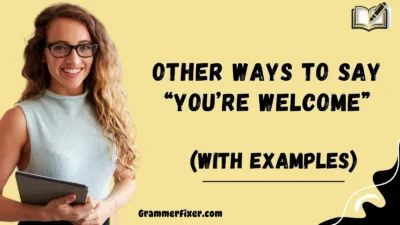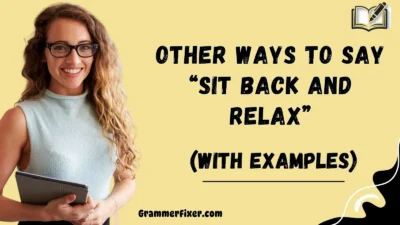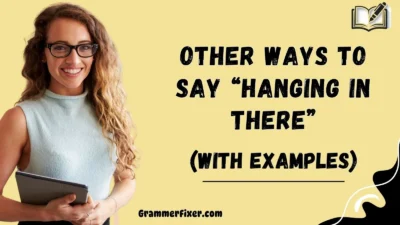Finding the right words in both spoken and written communication can make your message more empathetic, thoughtful, and meaningful. While the phrase “as well as” is commonly used to link ideas, clauses, or items, exploring other alternatives can help you avoid repetition, add variety to your writing, and adapt your tone depending on whether the setting is formal, academic, professional, or casual.
Below, we’ll explore 30 different ways to say “as well as,” with explanations, examples, and usage guidance to help you communicate with warmth and clarity.
What Does “as Well As” Mean?
The phrase “as well as” is a conjunction used to connect two or more elements in a sentence. It often implies inclusion, addition, or linkage without necessarily giving equal emphasis to all elements.
When to Use “as Well As”?
You should use “as well as” when you want to:
- Add information smoothly without repeating “and” too often.
- Link clauses, phrases, or items in a list for variety.
- Soften emphasis on the second item compared to the first.
- Maintain a more formal tone in writing, such as in academic papers, professional emails, or reports.
Is It Professional/Polite to Say “as Well As”?
Yes, “as well as” is considered professional, polite, and grammatically correct. It is widely used in business communication, academic writing, and formal settings. However, overusing it may sound repetitive, so having alternatives keeps your writing and speech dynamic and engaging.
Pros or Cons
Pros:
- Adds variety instead of overusing “and.”
- Works in both formal and informal contexts.
- Helps create a smooth, natural flow in sentences.
Cons:
- Can sometimes make sentences wordy.
- May confuse readers if punctuated incorrectly.
- Not always the best option for concise writing.
1. Also
Meaning: Indicates addition or inclusion.
Detailed Explanation: “Also” is a common synonym for “as well as,” but shorter and more direct, making it useful in both casual conversations and formal writing.
Scenario Example:
- “Sarah is responsible for the marketing campaign, also managing social media tasks.”
Best Use: Works well in concise sentences and business reports.
Worst Use: Avoid starting every sentence with “Also” in academic writing, as it may sound informal.
Tone: Neutral, straightforward.
2. In Addition
Meaning: Suggests extra or further information.
Detailed Explanation: “In addition” is more formal and works perfectly in essays, reports, and presentations.
Scenario Example:
- “The package includes free Wi-Fi, in addition to complimentary breakfast.”
Best Use: Academic and professional writing.
Worst Use: Overly casual conversations.
Tone: Formal, polished.
3. Additionally
Meaning: Another way to indicate “extra” or “furthermore.”
Detailed Explanation: Commonly used in academic writing and professional reports to build strong transitions.
Scenario Example:
- “The project was completed on time; additionally, it stayed within budget.”
Best Use: Formal reports, research, structured writing.
Worst Use: Everyday casual speech.
Tone: Professional, structured.
4. Along With
Meaning: Suggests being accompanied by or happening together.
Detailed Explanation: Works well when emphasizing that two things, people, or actions occur at the same time.
Scenario Example:
- “Marcus, along with his supervisor, presented the annual report.”
Best Use: Business, teamwork-related contexts.
Worst Use: Avoid when writing concise headlines.
Tone: Inclusive, collaborative.
5. Together With
Meaning: Indicates combined effort or presence.
Detailed Explanation: Stronger than “along with,” often implying unity and cooperation.
Scenario Example:
- “The CEO, together with the board members, announced new policies.”
Best Use: Formal meetings, group settings.
Worst Use: Overly casual speech.
Tone: Formal, respectful.
6. Coupled With
Meaning: Suggests a combination of two or more factors.
Detailed Explanation: Often used in academic, analytical, or technical writing.
Scenario Example:
- “High demand, coupled with limited supply, increased prices.”
Best Use: Research, professional reports.
Worst Use: Casual conversations.
Tone: Analytical, serious.
7. Together
Meaning: Implies being combined or united.
Detailed Explanation: Slightly simpler than “together with,” but still shows inclusion.
Scenario Example:
- “Snacks and drinks go together at every party.”
Best Use: Conversational, casual settings.
Worst Use: Academic writing.
Tone: Friendly, casual.
8. Plus
Meaning: Indicates addition in a casual, simple way.
Detailed Explanation: Useful for everyday speech, advertisements, or informal lists.
Scenario Example:
- “The hotel offers a stunning rooftop pool, plus free gym access.”
Best Use: Informal writing, marketing.
Worst Use: Academic essays.
Tone: Friendly, promotional.
9. Besides
Meaning: Indicates “apart from” or “in addition to.”
Detailed Explanation: Adds emphasis while also showing contrast.
Scenario Example:
- “Besides his academic achievements, Marcus excels in music.”
Best Use: Essays, storytelling.
Worst Use: Very technical or scientific writing.
Tone: Engaging, narrative.
10. Moreover
Meaning: Indicates “furthermore” or “in addition.”
Detailed Explanation: A very formal transition word, often used in structured writing.
Scenario Example:
- “The company reduced costs; moreover, efficiency increased by 20%.”
Best Use: Reports, formal presentations.
Worst Use: Casual speech.
Tone: Formal, academic.
11. Not to Mention
Meaning: Introduces an additional fact or point that adds weight to the statement.
Detailed Explanation: Often used when you want to emphasize something extra that strengthens your main argument.
Scenario Example:
- “The restaurant has excellent food, not to mention unmatched ambiance.”
Best Use: Persuasive writing, reviews.
Worst Use: Highly formal academic reports.
Tone: Emphatic, conversational.
12. Alongside
Meaning: Means “together with” or “happening at the same time.”
Detailed Explanation: Works well when showing that two actions, people, or tasks are happening in parallel.
Scenario Example:
- “The scientist conducted lab experiments alongside her students.”
Best Use: Academic, professional, and technical writing.
Worst Use: Very casual speech.
Tone: Collaborative, formal.
13. As Well
Meaning: A simpler variation of “as well as.”
Detailed Explanation: Commonly used in spoken English to indicate addition, though less formal than “as well as.”
Scenario Example:
- “He enjoys studying math, and science as well.”
Best Use: Informal writing, conversations.
Worst Use: Highly formal business reports.
Tone: Casual, warm.
14. Along
Meaning: Suggests happening in company or in addition.
Detailed Explanation: Works when describing activities or elements that occur together.
Scenario Example:
- “Snacks were served along drinks at the party.”
Best Use: Descriptive writing, casual settings.
Worst Use: Strict academic writing.
Tone: Simple, descriptive.
15. In Conjunction With
Meaning: Indicates joint action or combined effect.
Detailed Explanation: Heavily used in formal, legal, and professional documents.
Scenario Example:
- “The policy was created in conjunction with government agencies.”
Best Use: Contracts, legal, and professional communication.
Worst Use: Everyday conversations.
Tone: Formal, precise.
16. Together With That
Meaning: Emphasizes combined inclusion.
Detailed Explanation: Stronger than “together with,” often used to add another strong point.
Scenario Example:
- “The package includes a user manual, together with that, a warranty card.”
Best Use: Business and technical documents.
Worst Use: Overly casual chat.
Tone: Formal, explanatory.
17. Coupled To
Meaning: Suggests a strong connection between two elements.
Detailed Explanation: Works in contexts where cause and effect are highlighted.
Scenario Example:
- “The company’s innovative design, coupled to its aggressive marketing strategy, ensured success.”
Best Use: Analytical writing.
Worst Use: Friendly conversations.
Tone: Logical, formal.
18. To Boot
Meaning: An informal way of saying “as well as.”
Detailed Explanation: Adds an extra surprising point to make a statement stronger.
Scenario Example:
- “He’s a skilled painter, and a gifted musician to boot.”
Best Use: Informal speech, creative writing.
Worst Use: Professional reports.
Tone: Lighthearted, casual.
19. On Top of That
Meaning: Adds emphasis to an additional point.
Detailed Explanation: Great for persuasive or conversational writing to show emphasis.
Scenario Example:
- “The hotel has a rooftop pool. On top of that, it offers complimentary breakfast.”
Best Use: Marketing, everyday conversation.
Worst Use: Academic contexts.
Tone: Emphatic, persuasive.
20. Plus the Fact That
Meaning: Highlights something extra and often important.
Detailed Explanation: Commonly used to strengthen arguments by pointing out supporting details.
Scenario Example:
- “The software is user-friendly, plus the fact that it includes 24/7 support.”
Best Use: Reviews, product descriptions.
Worst Use: Technical legal writing.
Tone: Persuasive, explanatory.
21. In Combination With
Meaning: Suggests a mixture or joint usage.
Detailed Explanation: Often used in academic, scientific, or professional contexts.
Scenario Example:
- “This medicine should be taken in combination with a healthy diet.”
Best Use: Medical, technical, academic contexts.
Worst Use: Friendly chats.
Tone: Formal, technical.
22. With the Addition Of
Meaning: Indicates something added or included.
Detailed Explanation: Useful for showing incremental inclusion.
Scenario Example:
- “The design was improved with the addition of upgraded features.”
Best Use: Technical writing, product descriptions.
Worst Use: Casual speech.
Tone: Formal, descriptive.
23. In Association With
Meaning: Suggests partnership or collaboration.
Detailed Explanation: Common in business, professional, and event settings.
Scenario Example:
- “The festival was organized in association with local artists.”
Best Use: Business, collaborations, event promotions.
Worst Use: Daily conversations.
Tone: Professional, cooperative.
24. Hand in Hand With
Meaning: Indicates a strong natural partnership.
Detailed Explanation: Works well when describing things that complement each other.
Scenario Example:
- “Improved leadership skills go hand in hand with increased confidence.”
Best Use: Motivational, educational, or personal development writing.
Worst Use: Very technical reports.
Tone: Warm, inspirational.
25. Over and Above
Meaning: Suggests something extra beyond expectations.
Detailed Explanation: Highlights an additional benefit or quality.
Scenario Example:
- “She received recognition for her projects, over and above her regular tasks.”
Best Use: Professional praise, awards, achievements.
Worst Use: Extremely casual speech.
Tone: Respectful, appreciative.
26. Along the Lines Of
Meaning: Suggests similarity or addition in a certain way.
Detailed Explanation: Often used when comparing or suggesting something comparable.
Scenario Example:
- “The CEO proposed changes along the lines of previous strategies.”
Best Use: Business, professional discussions.
Worst Use: Strict academic tone.
Tone: Thoughtful, flexible.
27. In Tandem With
Meaning: Refers to two things working together in sync.
Detailed Explanation: Used in professional, scientific, or collaborative contexts.
Scenario Example:
- “The software runs in tandem with existing systems.”
Best Use: Technical, research, collaborative projects.
Worst Use: Friendly chats.
Tone: Professional, precise.
28. Together With It
Meaning: Indicates inclusion or attachment.
Detailed Explanation: Similar to “together with,” but emphasizes added presence.
Scenario Example:
- “The package contains a smartphone, together with it, a powerful charger.”
Best Use: Technical product details.
Worst Use: Informal casual use.
Tone: Neutral, descriptive.
29. In Like Manner
Meaning: Suggests something happening in a similar way.
Detailed Explanation: Used in formal, academic, or comparative contexts.
Scenario Example:
- “Employees should submit reports monthly; in like manner, managers should provide feedback.”
Best Use: Academic writing, comparative analysis.
Worst Use: Casual conversations.
Tone: Formal, comparative.
30. As Much As
Meaning: Can indicate both similarity and addition.
Detailed Explanation: Often used to show balance between two equal elements.
Scenario Example:
- “She values honesty as much as hard work.”
Best Use: Balanced expressions, personal values.
Worst Use: Overly technical writing.
Tone: Reflective, balanced.
Conclusion
The phrase “as well as” is a versatile, professional, and polite way to connect ideas, clauses, or items. But as with all language, relying on just one phrase can make your communication feel repetitive. By using these 30 alternatives, you can tailor your message to different contexts—whether it’s academic writing, business reports, casual conversations, or creative storytelling.



